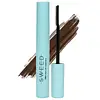What's inside
What's inside
 Key Ingredients
Key Ingredients

 Benefits
Benefits

 Concerns
Concerns

 Ingredients Side-by-side
Ingredients Side-by-side

Water
Skin ConditioningOryza Sativa Bran Wax
Skin ConditioningHydrogenated Olive Oil Stearyl Esters
Emulsion StabilisingIsododecane
EmollientAlcohol Denat.
AntimicrobialCopernicia Cerifera Wax
Palmitic Acid
EmollientStearic Acid
CleansingAcacia Senegal Gum
MaskingAminomethyl Propanediol
BufferingEuphorbia Cerifera Wax
Panthenol
Skin ConditioningPhenoxyethanol
PreservativePolyvinyl Alcohol
Vp/Va Copolymer
Chlorphenesin
AntimicrobialAscorbyl Palmitate
AntioxidantCI 77891
Cosmetic ColorantCI 77499
Cosmetic ColorantIron Oxides
CI 77492
Cosmetic ColorantWater, Oryza Sativa Bran Wax, Hydrogenated Olive Oil Stearyl Esters, Isododecane, Alcohol Denat., Copernicia Cerifera Wax, Palmitic Acid, Stearic Acid, Acacia Senegal Gum, Aminomethyl Propanediol, Euphorbia Cerifera Wax, Panthenol, Phenoxyethanol, Polyvinyl Alcohol, Vp/Va Copolymer, Chlorphenesin, Ascorbyl Palmitate, CI 77891, CI 77499, Iron Oxides, CI 77492
Water
Skin ConditioningPEG-12 Carnauba
Emulsion StabilisingPEG-8 Beeswax
EmulsifyingStyrene/Acrylates/Ammonium Methacrylate Copolymer
Vp/Eicosene Copolymer
Paraffin
PerfumingPvp
Emulsion StabilisingStearyl Alcohol
EmollientPalmitic Acid
EmollientStearic Acid
CleansingAminomethyl Propanediol
BufferingBis-Diglyceryl Polyacyladipate-2
EmollientPentylene Glycol
Skin ConditioningPhenoxyethanol
PreservativeButylene Glycol
HumectantHydroxyethylcellulose
Emulsion StabilisingCaprylyl Glycol
EmollientCrambe Abyssinica Seed Oil
Skin ConditioningSodium Laureth-12 Sulfate
CleansingTetrasodium EDTA
Decyloxazolidinone
AntimicrobialTocopheryl Acetate
AntioxidantGossypium Herbaceum Extract
Skin ConditioningAmmonium Hydroxide
BufferingHydrolyzed Soy Protein
HumectantBHT
AntioxidantCI 19140
Cosmetic ColorantCI 42090
Cosmetic ColorantCI 77007
Cosmetic ColorantCI 77163
Cosmetic ColorantCI 77288
Cosmetic ColorantCI 77289
Cosmetic ColorantIron Oxides
CI 77510
Cosmetic ColorantCI 77742
Cosmetic ColorantCI 77891
Cosmetic ColorantWater, PEG-12 Carnauba, PEG-8 Beeswax, Styrene/Acrylates/Ammonium Methacrylate Copolymer, Vp/Eicosene Copolymer, Paraffin, Pvp, Stearyl Alcohol, Palmitic Acid, Stearic Acid, Aminomethyl Propanediol, Bis-Diglyceryl Polyacyladipate-2, Pentylene Glycol, Phenoxyethanol, Butylene Glycol, Hydroxyethylcellulose, Caprylyl Glycol, Crambe Abyssinica Seed Oil, Sodium Laureth-12 Sulfate, Tetrasodium EDTA, Decyloxazolidinone, Tocopheryl Acetate, Gossypium Herbaceum Extract, Ammonium Hydroxide, Hydrolyzed Soy Protein, BHT, CI 19140, CI 42090, CI 77007, CI 77163, CI 77288, CI 77289, Iron Oxides, CI 77510, CI 77742, CI 77891
 Reviews
Reviews

Ingredients Explained
These ingredients are found in both products.
Ingredients higher up in an ingredient list are typically present in a larger amount.
We don't have a description for Aminomethyl Propanediol yet.
Ci 77891 is a white pigment from Titanium dioxide. It is naturally found in minerals such as rutile and ilmenite.
It's main function is to add a white color to cosmetics. It can also be mixed with other colors to create different shades.
Ci 77891 is commonly found in sunscreens due to its ability to block UV rays.
Learn more about CI 77891Palmitic Acid is a fatty acid naturally found in our skin and in many plant and animal sources. In cosmetics, it is usually derived from palm oil. It serves many purposes in skincare, acting as a cleanser, emollient, and emulsifier.
As an emollient, palmitic acid helps soften and smooth the skin by preventing water loss. In cleansers, it helps remove oil and dirt while creating foam.
Its emulsifying properties help stabilize products by keeping water and oil-based ingredients from separating.
This may not be suitable for fungal acne-prone skin, as fatty acids like this can sometimes trigger breakouts in sensitive individuals.
Learn more about Palmitic AcidPhenoxyethanol is a preservative that has germicide, antimicrobial, and aromatic properties. Studies show that phenoxyethanol can prevent microbial growth. By itself, it has a scent that is similar to that of a rose.
It's often used in formulations along with Caprylyl Glycol to preserve the shelf life of products.
Stearic Acid is a fatty acid. It is an emollient, emulsifier, and texture enhancer.
As an emollient, stearic acid helps soften skin. It aids the skin's protective barrier by preventing water loss. It also provides a gentle cleansing effect without stripping away natural oils.
Stearic acid may also be used to enhance the texture of products. It can add volume and stabilize ingredients such as water and oil. This can help water and oil ingredients from separating.
Sources of stearic acid include animal or vegetable fats/oils such as coconut or shea. It can be naturally found in butter, cocoa butter, shea butter, vegetable fats, and animal tallow.
This ingredient may not be Malassezia folliculitis, or fungal-acne safe.
Learn more about Stearic AcidWater. It's the most common cosmetic ingredient of all. You'll usually see it at the top of ingredient lists, meaning that it makes up the largest part of the product.
So why is it so popular? Water most often acts as a solvent - this means that it helps dissolve other ingredients into the formulation.
You'll also recognize water as that liquid we all need to stay alive. If you see this, drink a glass of water. Stay hydrated!
Learn more about WaterThis ingredient is a combination of red, black, and yellow iron oxide pigments. This combination of colors is usually found in foundation, because it results in a "skin" color.